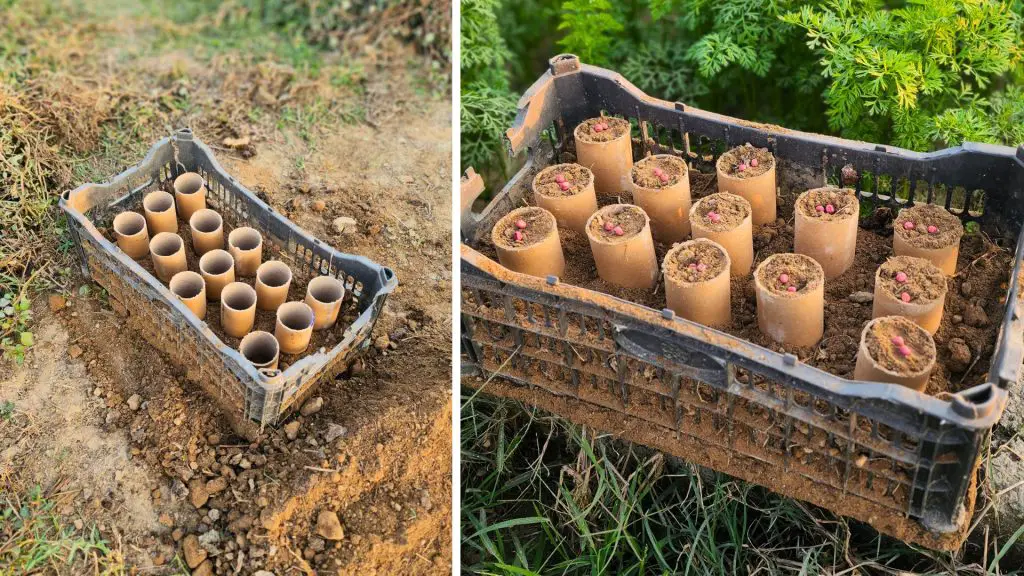Homemade seed planting containers made from simple cardboard tubes offer one of the easiest and most eco-friendly ways to start seeds at home. They cost nothing, they reduce waste, and most importantly, they allow seedlings to be transplanted without disturbing their roots. This leads to stronger, healthier plants that settle into the garden faster.

These containers break down naturally in the soil, giving roots an easy path to grow deeper. With a little preparation and a few simple ingredients, anyone can set up a reliable seed-starting system using materials already found around the house.
This method works especially well for vegetables like peas, beans, cucumbers, and many other crops that don’t like their roots being disturbed during transplanting. The steps are simple, and the entire process creates a friendly environment for seeds to grow comfortably from day one.
Making the Containers
To begin, the main material needed is cardboard tubes. These tubes can come from wallpaper rolls, paper towel rolls, or any thick cardboard core. They are strong when dry but soften naturally over time, which is perfect for seedlings because the tube will slowly break down in the soil after transplanting.
Start by marking each tube at a height of around three inches. This size is ideal because it gives the seed enough soil depth to develop early root growth while keeping the container small and easy to manage. After marking, cut the tubes into individual sections.
There is no need to create a bottom for the containers because they are meant to be bottomless. The open bottom will allow the roots to move downward easily and help the seedling anchor itself as soon as it is placed in garden soil later.
Once the cutting is done, check each tube to ensure the edges are smooth and even. The tubes should be firm enough to stand upright once filled with soil. If a tube feels too weak, you can wrap a thin strip of cardboard around it for extra support, but most wallpaper tubes are strong enough as they are.
Making a batch of these containers takes only a few minutes and uses materials that would otherwise be thrown away. This makes the method both sustainable and extremely practical for gardeners who want low-cost solutions.
Watch complete video here
Preparing the Soil Mix
A good soil mix is one of the biggest factors in successful seed starting. Seeds need moisture, nutrients, and air circulation around their roots. The mix must not be too heavy, or it will compact and suffocate the roots, and it must not be too light, or it will dry out quickly.
The best combination for this project is equal parts loamy garden soil and fully decomposed manure. Loamy soil gives the mixture a soft texture with good drainage, while the manure enriches it with nutrients that young seedlings need in their first few weeks.
After mixing these base ingredients, two natural additives can be included to make the soil even more beneficial. Bone meal helps with root development and supports stronger early growth. Neem cake powder protects the roots from harmful pests and also adds mild nutrients while improving soil health.
Each additive provides a specific benefit in a simple and natural way. When everything is added together, mix thoroughly until the soil feels uniform in texture. The goal is to have a soft, crumbly mix that holds moisture well but does not get soggy.
Setting Up the Basket System
Once the containers and soil are ready, the next step is arranging them in a stable setup. A simple fruit basket, especially the plastic mesh kind, works perfectly for this. The basket allows water to drain easily, lets air circulate, and keeps all the containers standing upright without falling over.
Fill the bottom of the basket with some of the soil mix. This layer provides a base so the cardboard tubes can sit firmly and stay in place. It also allows roots to grow downward through the bottom of the tube and into the extra soil once the seedlings start to develop.
Arrange the cardboard containers inside the basket, pressing each one slightly into the soil so they do not shift. When all tubes are in place, fill each one with the prepared soil mix. Tap gently on the sides to help the soil settle, but do not press too hard.
A lightly filled tube allows the seed roots to spread easily and evenly. This basket method keeps all the tubes organized in one spot, making it easier to water and care for them during the early growing period.
Planting the Seeds
With the tubes filled with soil, it is time to plant the seeds. Peas are an excellent choice because they grow quickly, sprout strongly, and benefit greatly from root protection during transplanting. Place two pea seeds in each container.
Planting two seeds increases the chance of getting at least one strong plant per tube. If both seeds sprout, you can grow both or remove the weaker one later depending on your garden space. Cover the seeds with a thin layer of soil and press gently so the seeds stay in contact with the moist soil.
After planting, water slowly and carefully. Use a gentle watering method so the soil stays in place and does not spill out of the tubes. The first watering is important because it helps settle the soil and gives the seeds the moisture they need to start germinating. The tubes should feel damp all the way through but not flooded.
